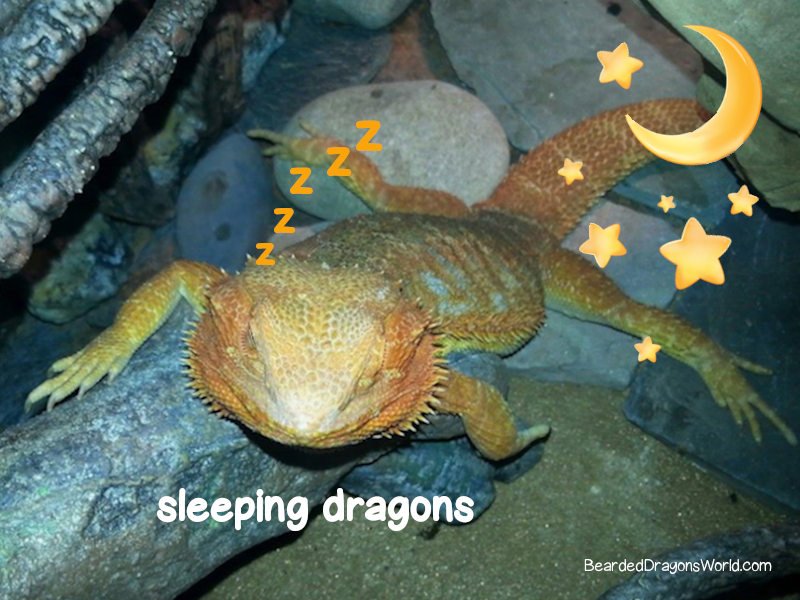Understanding bearded dragon sleep patterns can be as fascinating as it is crucial for their well-being. Recent scientific studies have shed light on the sleep states of lizards, offering insights that can help us provide better care for our scaly companions.
In many ways, bearded dragons sleep just like humans do: at night, with the lights off.
Jump To…
When Does a Bearded Dragon Sleep?
Bearded dragons, much like humans, are diurnal creatures, active during the day and asleep at night. In their natural habitat, they align their sleep-wake cycles with the sun. This means your bearded dragon should ideally be sleeping when you do, typically requiring 8-12 hours of sleep. Ensuring their enclosure mimics natural light cycles and maintaining darkness during sleep hours is essential for their well-being.
Bearded dragons are able to manage their own sleep as long as they have the right environment. Setting lighting and heating cycles to mimic that of their natural environment in the different seasons will assist in providing the right environment.
Does a Bearded Dragon Sleep With Its Eyes Closed?
Bearded dragons sleep with their eyes closed. However, they can be very sensitive to light, and may open their eyes if they sense light near them.
Pet owners who think their bearded dragon sleeps with their eyes open may be mistaken – it’s more likely that it only opened its eyes because the lights were turned on to check on them or some movement was detected by the animal.
If your bearded dragon is keeping its eyes open throughout the night, with the lights off, you may want to take it to the vet.
Do Bearded Dragons Have REM sleep?
For years, it was believed that only mammals and birds experienced two distinct sleep states – REM and slow-wave sleep. This belief was rooted in the understanding that these complex sleep patterns were exclusive to warm-blooded animals. However, recent studies have brought our cold-blooded companions, the reptiles, into this fascinating sleep conversation.
What Does the Research Say?
A study delving into sleep in reptiles has reported that about a third of the research on reptilian sleep identified a REM sleep-like state. But, and here’s the twist, none of these studies provide conclusive evidence to establish a true homology with the REM sleep we see in mammals. This means that while reptiles might show some signs similar to REM sleep, it’s not quite the same thing. As reptiles don’t exhibit all the traits defining mammalian REM sleep, the question of whether they experience this sleep state remains open.
While we can’t yet definitively say they experience REM sleep as we do, it’s clear that their sleep is more complex than we previously thought. This understanding can help us better cater to their needs. For instance, ensuring that your reptilian pet has a comfortable, quiet place to rest can contribute significantly to its overall health and well-being.
Do Bearded Dragons Dream?
Research by Shein-Idelson et al, 2016 indicated that bearded dragons, like mammals and birds, experience slow-wave and REM sleep.
In humans and other mammals, the sleep cycle lasts about 60 to 90 minutes, and mostly consists of slow-wave sleep interrupted by brief periods of REM sleep. It’s during this REM sleep that we dream.
The bearded dragon’s sleep cycle is much shorter and more regular. Its 80-second cycle is split evenly between slow-wave and REM sleep (Shein-Idelson et al, 2016).
Creating a Sleep-Friendly Habitat
Understanding that reptiles have their unique sleep patterns, it’s important to create an environment that supports healthy sleep. This includes maintaining a consistent light-dark cycle, providing a comfortable and secure sleeping area, and minimizing disturbances during their resting hours. Observing your bearded dragons sleep patterns can also give you insights into their overall health and well-being.
5 Surprising Bearded Dragon Sleep Habits
If you find your bearded dragon doing any of the following things, there’s no reason to panic! There are many surprising bearded dragon sleep habits that are totally healthy.
- Strange Sleeping Positions
Though bearded dragons usually sleep lying on their stomachs, there are many other positions some may prefer. There’s nothing wrong with letting your bearded dragon sleep on its back, standing up, or even clinging to a wall! Your pet’s preferred sleeping position may also change over its lifetime.

- Extended Sleep Periods
During the late fall and winter months, it’s not unusual for bearded dragons to nap for days or even weeks. This is because your bearded dragon has entered a period called brumation. This is essentially hibernation for reptiles. For more information on brumation, check out our comprehensive article (https://beardeddragonsworld.com/bearded-dragon-brumation/).

- Changing Color While Sleeping
You might notice your bearded dragon changing to a lighter color when it’s asleep. Researchers from the University of Exeter and University of Melbourne discovered that these bearded dragons shift from dark hues in the morning to lighter shades by night. Intriguingly, this pattern continues even in the absence of light for 24 hours, indicating a deeper biological clock at work.
The change in color is tied to the sleep-wake cycle of the lizards. At night, while resting, the dark melanin pigment contracts towards the center of the skin cells, and during the day, it disperses to the surface. This physiological resting state signifies the lowest energy state for the pigment cells. (Nogrady, 2014).
- Sand As A Sleep Aid
Bearded dragons often like to cover themselves in sand. You might find that your pet has partially buried itself to go to sleep.
While you should make sure that there is no negative reason for this behavior (for instance, an annoying light it is trying to get away from, or a more dominant bearded dragon in the cage), there is nothing inherently unhealthy in this habit.
- Breathing very slowly
It can be a shock to find your bearded dragon asleep, and not be sure if it’s breathing. Fortunately, this is often a false alarm. Bearded dragons can seriously slow their metabolic and respiratory rate when they’re in a deep sleep.
Sometimes they can breathe so slowly and quietly that you can’t tell if they’re alive. But don’t worry – this is totally normal.
Effects of Sleep Deprivation
Just like humans, bearded dragons can be affected by sleep deprivation. Studies involving gentle-handling sleep deprivation in lizards have shown changes in their sleep-related brain waves, emphasizing the importance of uninterrupted sleep for their health (Libourel, et al. 2018).
Conclusion: Bearded Dragon Sleep
Though bearded dragon sleep habits are similar to those of humans, they have many sleeping positions we may find strange.
If your bearded dragon seems abnormally sleepy or lethargic during the day, check for underlying problems including stress, and speak with your vet.
Have you ever been surprised by your bearded dragons sleeping habits? Tell us about it in the comments below! We love to hear from you.
Do bearded dragons sleep with their eyes closed?
Bearded dragons sleep with their eyes closed, though they may open them if they sense light.
Do bearded dragons experience REM sleep?
Yes, researchers have found that bearded dragons experience slow-wave and REM sleep in 80-second cycles.
How long do bearded dragons sleep?
Bearded dragons usually sleep 8-12 hours a night.
References
- Libourel, P. A., Barrillot, B., Arthaud, S., Massot, B., Morel, A. L., Beuf, O., Herrel, A., & Luppi, P. H. (2018) Partial homologies between sleep states in lizards, mammals, and birds suggest a complex evolution of sleep states in amniotes. PLoS Biology, 16(10).
- Nogrady, B. (2014) Bearded dragon’s colour matches body clock. News in Science. ABC Science.
- Shein-Idelson, M., Ondracek, J., Liaw, H.-P., Reiter, S. and Laurent, G. (2016) Slow waves, sharp-waves, ripples and REM in sleeping dragons. Max-Planck-Gesellschaft
- Libourel, P.-A., Barrillot, B., Arthaud, S., Massot, B., Morel, A.-L., Beuf, O., Herrel, A., & Luppi, P.-H. (2018). Partial homologies between sleep states in lizards, mammals, and birds suggest a complex evolution of sleep states in amniotes. PLOS Biology, 16(10), e2005982.
- Ungurean, G., Barrillot, B., Martinez-Gonzalez, D., Libourel, P.-A., & Rattenborg, N. C. (2020). Comparative Perspectives that Challenge Brain Warming as the Primary Function of REM Sleep. IScience, 23(11), 101696.







My beardie likes to sleep in my bed on her own pill covered by her own baby blanket and a dark towel folded over several times cuddle up to a teddy bear. When it gets to cold she will seek me out and curl up next to me and stay next to me and I know she is there and am very careful to not move.
My bearded dragon occasionally sleeps with her arm in the air when she’s relaxing
My dragon will randomly fall asleep in her water or food bowl. When she sleeps in her water her head is vertical against the glass.
It can appear random for us, but I think they know exactly what they are doing. Are the bowls near heat? Away from heat? Low to the ground or higher? Could be their location, temperature, some sense of security perhaps.
I found my beardie sleeping in her water dish. I took her out and when I went back to check in her, she climbed back in. She had her head snuggly propped up over the side but I got concerned her body temp would get too low or she might slip in while sleeping deeply and aspirate. Thoughts?
I would have done the same as you for the same reasons as you. Could take the dish out during the night if it is a problem. Great job caring for her.
I just added some plants in my beardies tank and now he sleeps in them standing up…it’s so funny…